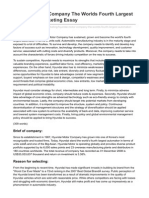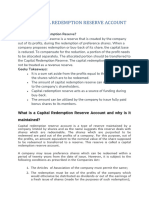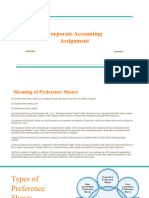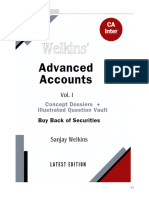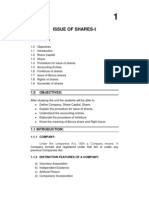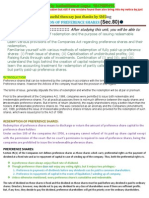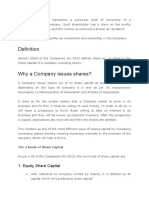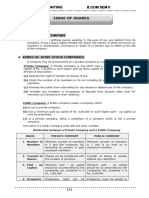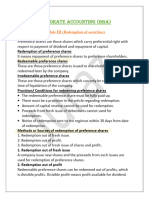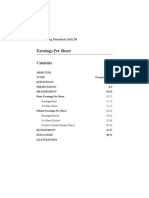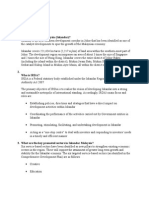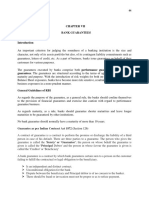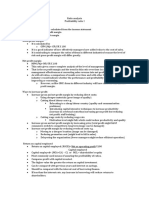Company Acc Unit 5
Company Acc Unit 5
Uploaded by
Megha DevanpalliCopyright:
Available Formats
Company Acc Unit 5
Company Acc Unit 5
Uploaded by
Megha DevanpalliOriginal Title
Copyright
Available Formats
Share this document
Did you find this document useful?
Is this content inappropriate?
Copyright:
Available Formats
Company Acc Unit 5
Company Acc Unit 5
Uploaded by
Megha DevanpalliCopyright:
Available Formats
COMPANY ACCOUNTS 11.
151
UNIT – 5: REDEMPTION OF PREFERENCE SHARES
LEARNING OUTCOMES
After studying this unit, you will be able to:
♦ understand the meaning of redemption and the purpose of issuing
redeemable preference shares;
♦ learn various provisions of the Companies Act, 2013 regarding
preference shares and their redemption;
♦ familiarise yourself with various methods of redemption of fully
paid-up preference shares by:
(i) Fresh issue of shares; Or
(ii) Capitalisation of divisible or undistributed profits; Or
(iii) Combination of (i) and (ii) above;
♦ understand the logic behind the creation of Capital Redemption
Reserve;
♦ learn the accounting treatment for redemption of:
(i) fully paid-up preference shares;
(ii) partly called-up preference shares; and
(iii) fully called-up but partly paid-up preference shares.
© The Institute of Chartered Accountants of India
a 11.152 ACCOUNTING
UNIT OVERVIEW
Methods of redemption of Preference shares
(b) By capitalisation of (c) By combination of (a)
(a) By fresh issue of shares
undistributed profits and (b)
(a) Towards issue of un-issued shares of the
company to be issued to members of the company
Section 52 of the Companies Act, as fully paid bonus securities
2013 provides that the securities
premium account may be applied (b) To write off preliminary expenses of the
by the company: company
[NOTE: Certain class of Companies
(c) To write off the expenses of, or commission
whose financial statements comply paid, or discount allowed on any of the securities or
with the Accounting Standards as debentures of the company
prescribed under Section 133 of
the Companies Act, 2013, can’t (d) To provide for premium on the redemption of
redeemable preference shares or debentures of the
apply the securities premium company.
account for the purposes (b) and
(d)]
(e) For the purchase of its own shares or other
securities.
5.1 INTRODUCTION
Redemption is the process of repaying an obligation, at prearranged amounts and timings. It
is a contract specifying the obligation to redeem preference shares within or at the end of a
given time period at an agreed price. These shares are issued on the terms that shareholders
will at a future date be repaid the amount which they invested in the company (apart from
the frequent payments of a specified amount of dividend as return on investment during the
tenure of the preference shares). The redemption date is the maturity date, which specifies
when repayment is scheduled to take place and is usually printed on the preference share
certificate. Through the process of redemption, a company can also adjust its financial
structure, for example, by eliminating preference shares and replacing those with other
securities if future growth of the company makes such change advantageous.
© The Institute of Chartered Accountants of India
COMPANY ACCOUNTS 11.153
5.2 PURPOSE OF ISSUING REDEEMABLE PREFERENCE
SHARES
A company may issue redeemable preference shares because of the following:
1. It is a proper way of raising finance in a dull primary market.
2. A company may face difficulty in raising share capital, as its shares are not traded on
the stock exchange. Potential investors who may, hesitate in putting money into shares
that cannot easily be sold may be encouraged to invest if the shares are redeemable
by the company.
3. The preference shares may be redeemed when there is a surplus of capital and the
surplus funds cannot be utilised in the business for profitable use.
4. No dividend is required to be paid, if there is loss or no profit, whereas interest is
payable on debentures or loans even in case of loss. In other words, preference
dividend declared / paid continues to be regarded as an appropriation of profits
(similar treatment is given for equity shares), as against interest on debentures, which
is a charge against profits.
In India, the issue and redemption of preference shares is governed by Section 55 of the
Companies Act, 2013.
5.3 PROVISIONS OF THE COMPANIES ACT
(SECTION 55)
A company limited by shares if so authorised by its Articles, may issue preference shares which
at the option of the company, are liable to be redeemed within a period, normally not
exceeding 20 years from the date of their issue. It should be noted that:
(a) no shares can be redeemed except out of divisible or distributable profit, (i.e. out of
the profit of the company which would otherwise be available for dividend) or out of
proceeds of fresh issue of shares made for the purpose of redemption;
(b) no such shares can be redeemed unless they are fully paid;
(c) (i) in case of such class of companies, as may be prescribed and whose financial
statement comply with the accounting standards prescribed for such class of
companies under Section 133, the premium, if any, payable on redemption shall
be provided for out of the profits of the company, before the shares are
redeemed:
© The Institute of Chartered Accountants of India
a 11.154 ACCOUNTING
Provided also that premium, if any, payable on redemption of any preference
shares issued on or before the commencement of this Act by any such company
shall be provided for out of the profits of the company or out of the company’s
securities premium account, before such shares are redeemed.
(ii) in case of other companies (not falling under (i) above), the premium, if any
payable on redemption shall be provided for out of the profits of the company or
out of the company’s securities premium account, before such shares are
redeemed.
(Refer to the Note given in para 5.4.1 for the basis applied in the Illustrations in
this Chapter.)
(d) where any such shares are proposed to be redeemed out of the profits of the company,
there shall, out of the divisible profits, i.e. the profits which would otherwise have been
available for dividends, be transferred to a reserve account to be called Capital
Redemption Reserve Account, a sum equal to the nominal amount of the shares
redeemed; and the provisions of the Act relating to the reduction of the share capital of
a company shall, except as provided in the Section, apply as if the Capital Redemption
Reserve (CRR) Account were the paid-up share capital of the company. The utilisation of
CRR Account is further restricted to issuance of fully paid-up bonus shares only.
From the legal provision outlined above, it is apparent that on the redemption of redeemable
preference shares out of accumulated divisible profits, it will be necessary to transfer to the
Capital Redemption Reserve Account an amount equal to the amount repaid on the
redemption of preference shares on account of face value less proceeds of a fresh issue of
shares made for the purpose of redemption. The object is that with the repayment of
redeemable preference shares, the security for creditors/ bankers, etc. should not be reduced.
At times, a part of the preference share capital may be redeemed out of accumulated divisible
profits and the balance out of a fresh issue.
5.4 METHODS OF REDEMPTION OF FULLY PAID-UP
SHARES
Redemption of preference shares means repayment by the company of the obligation on
account of shares issued. According to the Companies Act, 2013, preference shares issued by
a company must be redeemed within the maximum period (normally 20 years) allowed under
the Act. Thus, a company cannot issue irredeemable preference shares.
Section 55 of the Companies Act, 2013, deals with provisions relating to redemption of
preference shares. It ensures that there is no reduction in shareholders’ funds due to
© The Institute of Chartered Accountants of India
COMPANY ACCOUNTS 11.155
redemption and, thus, the interest of outsiders is not affected. For this, it requires that either
fresh issue of shares is made, or distributable profits are retained and transferred to ‘Capital
Redemption Reserve Account’.
The rationale behind these provisions is to protect the interest of outsiders to whom the
amount is payable before redemption of preference share capital. The interest of outsiders is
protected if the nominal value of capital redeemed is substituted, thus, ensuring the same
amount of shareholders’ fund.
In case of redemption of preference shares out of proceeds of a fresh issue of shares,
replacement of capital and tangible assets is obvious.
If redemption is done out of distributable profits, replacement of capital is ensured in
an indirect manner by retention of profit by transfer to Capital Redemption Reserve.
In this case, the amount which would have otherwise gone to shareholders in the form
of dividend is retained in the business and is used for settling the claim of preference
shareholders. Thus, there is no additional drain from the net assets of the Company.
The transfer of divisible profits to Capital Redemption Reserve makes them non-
divisible profits. As Capital Redemption Reserve can be used only for issue of fully paid
bonus shares, profits retained in the business ultimately get converted into share
capital.
Security cover available to outside stakeholders depends upon called-up capital as well as
uncalled capital to be demanded by the company as per its requirements. To ensure that the
interests of outsiders are not reduced, Section 55 provides for redemption of only fully paid-
up shares.
From the above paras, it can be concluded that the ‘gap’ created in the company’s capital by
the redemption of redeemable preference shares must be filled in by:
(a) the proceeds of a fresh issue of shares; or
(b) the capitalisation of undistributed profits (by creating Capital Redemption Reserve); or
(c) a combination of (a) and (b) above.
5.4.1 Redemption of Preference Shares by Fresh Issue of Shares
One of the methods for redemption of preference shares is to use the proceeds of a fresh
issue of shares. A company can issue new shares (equity shares or preference shares) and the
proceeds from such new shares can be used for redemption of preference shares.
© The Institute of Chartered Accountants of India
a 11.156 ACCOUNTING
The proceeds from issue of debentures cannot be utilised for the purpose.
A problem arises when a fresh issue is made for the purpose of redemption of preference
shares, at a premium. The point to ponder is that whether the proceeds of a fresh issue of
shares will include the amount of securities premium for the purpose of redemption of
preference shares.
For securities premium account, Section 52 of the Companies Act, 2013 provides that the
securities premium account may be applied by the company;
(a) Towards issue of un-issued shares of the company to be issued to members of the
company as fully paid bonus securities
(b) To write off preliminary expenses of the company
(c) To write off the expenses of, or commission paid, or discount allowed on any of the
securities or debentures of the company
(d) To provide for premium on the redemption of redeemable preference shares or
debentures of the company.
(e) For the purchase of its own shares or other securities.
Note: It may be noted that certain class of Companies whose financial statements comply with
the Accounting Standards as prescribed under Section 133 of the Companies Act, 2013, can’t
apply the securities premium account for the purposes (b) and (d) mentioned above.
Note: All the questions in this chapter have been solved on the basis that the companies
referred in the questions are governed by Section 133 of the Companies Act, 2013 and comply
with the Accounting Standards prescribed for them. Accordingly the balance in securities
premium account has not been utilized for the purpose of premium payable on redemption
of preference shares.
Any other way, except the above prescribed ways, in which securities premium account is
utilised will be in contravention of law.
Thus, the proceeds of a fresh issue of shares will not include the amount of securities premium
for the purpose of redemption of preference shares.
Reasons for issue of New Equity Shares
A company may prefer issue of new equity shares for the following reasons:
(a) When the company has come to realise that the capital is needed permanently and it
makes more sense to issue Equity Shares in place of Redeemable Preference Shares as
Preference Shares carry a fixed rate of dividend.
© The Institute of Chartered Accountants of India
COMPANY ACCOUNTS 11.157
(b) When the balance of profit, which would otherwise be available for dividend, is
insufficient.
(c) When the liquidity position of the company is not good enough.
Advantages of redemption of preference shares by issue of fresh equity shares
Following are the advantages of redemption of preference shares by the issue of fresh equity
shares:
(1) No cash outflow of money – now or later.
(2) New equity shares may be valued at a premium.
(3) Shareholders retain their equity interest.
Disadvantages of redemption of preference shares by issue of fresh equity shares
The disadvantages are:
(1) There will be dilution of future earnings;
(2) Share-holding in the company is changed if the fresh issue is made to outsiders. In
case the fresh issue is made to existing shareholders in proportion to their
shareholding (i.e., rights issue), the disadvantage of change in shareholding pattern
can be mitigated.
5.4.2 Accounting Entries
1. When new shares are issued at par
Bank Account Dr.
To Share Capital Account
(Being the issue of …….shares of `……each for the purpose of redemption
of preference shares, as per Board’s Resolution No…… dated……. )
2. When new shares are issued at a premium
Bank Account Dr.
To Share Capital Account
To Securities Premium Account
(Being the issue of ……..shares of `……each at a premium of `……each
for the purpose of redemption of preference shares as per Board’s
Resolution No….. dated……)
© The Institute of Chartered Accountants of India
a 11.158 ACCOUNTING
3. When preference shares are redeemed at par
Redeemable Preference Share Capital Account Dr.
To Preference Shareholders Account
4. When preference shares are redeemed at a premium
Redeemable Preference Share Capital Account Dr.
Premium on Redemption of Preference Shares Account Dr.
To Preference Shareholders Account
5. When payment is made to preference shareholders
Preference Shareholders Account Dr.
To Bank Account
6. For adjustment of premium on redemption
Profit and Loss Account Dr.
To Premium on Redemption of Preference Shares Account
ILLUSTRATION 1
Hinduja Company Ltd. had 5,000, 8% Redeemable Preference Shares of ` 100 each, fully paid
up. The company decided to redeem these preference shares at par by the issue of sufficient
number of equity shares of ` 10 each fully paid up at par. You are required to pass necessary
Journal Entries including cash transactions in the books of the company.
SOLUTION
In the books of Hinduja Company Ltd.
Journal Entries
Date Particulars Dr. (`) Cr. (`)
Bank A/c Dr. 5,00,000
To Equity Share Capital A/c 5,00,000
(Being the issue of 50,000 Equity Shares of `10
each at par for the purpose of redemption of
preference shares, as per Board Resolution No.
……..dated……..)
© The Institute of Chartered Accountants of India
COMPANY ACCOUNTS 11.159
8% Redeemable Preference Share Capital A/c Dr. 5,00,000
To Preference Shareholders A/c 5,00,000
(Being the amount payable on redemption of
preference shares transferred to Preference
Shareholders Account)
Preference Shareholders A/c Dr. 5,00,000
To Bank A/c 5,00,000
(Being the amount paid on redemption of
preference shares)
ILLUSTRATION 2
C Ltd. had 10,000, 10% Redeemable Preference Shares of ` 100 each, fully paid up. The
company decided to redeem these preference shares at par, by issue of sufficient number of
equity shares of ` 10 each at a premium of ` 2 per share as fully paid up. You are required
to pass necessary Journal Entries including cash transactions in the books of the company.
SOLUTION
In the books of C Ltd.
Journal Entries
Date Particulars Dr. (`) Cr. (`)
Bank A/c Dr. 12,00,000
To Equity Share Capital A/c 10,00,000
To Securities Premium A/c 2,00,000
(Being the issue of 1,00,000 Equity Shares of `10
each at a premium of `2 per share as per Board’s
Resolution No….. dated……….)
10% Redeemable Preference Share Capital A/c Dr. 10,00,000
To Preference Shareholders A/c 10,00,000
(Being the amount payable on redemption of
preference shares transferred to Preference
Shareholders A/c)
Preference Shareholders A/c Dr. 10,00,000
To Bank A/c 10,00,000
(Being the amount paid on redemption of
preference shares)
© The Institute of Chartered Accountants of India
a 11.160 ACCOUNTING
Note: Amount required for redemption is ` 10,00,000. Therefore, face value of equity shares
to be issued for this purpose must be equal to ` 10,00,000. Premium received on new issue
cannot be used to finance the redemption.
ILLUSTRATION 3
G India Ltd. had 9,000 10% redeemable Preference Shares of ` 10 each, fully paid up. The
company decided to redeem these preference shares at par by the issue of sufficient number
of equity shares of ` 9 each fully paid up.
You are required to pass necessary Journal Entries including cash transactions in the books of
the company.
SOLUTION
In the books of G India Limited
Journal
Date Particulars Dr. Cr. (`)
(` )
Bank A/c Dr. 90,000
To Equity Share Capital A/c 90,000
(Being the issue of 10,000 Equity Shares of `9 each at par,
as per Board’s Resolution No…….Dated…..)
10% Redeemable Preference Shares Capital A/c Dr. 90,000
To Preference Shareholders A/c 90,000
(Being the amount payable on redemption of preference
shares transferred to Preference Shareholders A/c)
Preference Shareholders A/c Dr. 90,000
To Bank A/c 90,000
(Being the amount paid on redemption of preference
shares)
5.4.3 Calculation of Minimum Fresh Issue of Shares
Sometimes, examination problem does not specify the number of shares to be issued for the
purpose of redemption of preference shares and requires that the minimum number of shares
should be issued to ensure that provisions of Section 55 of the Companies Act, 2013, are not
violated. This is done in four steps as given below:
(1) In such cases, the maximum amount of reserves and surplus available for redemption
is ascertained taking into account the balances appearing in the balance sheet before
© The Institute of Chartered Accountants of India
COMPANY ACCOUNTS 11.161
redemption and the additional information provided in the problem. For example, if
balance of general reserve in the balance sheet is `1,00,000 and additional information
provides that the Board of Directors have decided that the balance of general reserve
should not be less than `40,000 under any circumstances, then, the maximum amount
of general reserve available for redemption is ` 60,000.
(2) After ascertaining the maximum amount of reserves and surplus available for
redemption, adjustment for premium on redemption payable out of profits is made and
then it is compared with the nominal value of shares to be redeemed. By comparison,
one gets the minimum proceeds of fresh issue as Section 55 permits redemption either
out of proceeds of fresh issue or out of divisible profits. Thus,
Minimum Proceeds of Fresh Issue of shares :
Nominal value of preference shares to be redeemed – Maximum amount of reserve and
surplus available for redemption.
(3) After computation of minimum proceeds, the minimum number of shares to be issued
are determined by dividing minimum proceeds by the proceeds of one share. This is
done as follows:
Minimum Number of Shares = Minimum proceeds to comply with Section 55/ face value
of one share
Proceeds of one share mean the par value of a share issued, if it is issued at par or
premium. However, in case of issue of share at a discount, it refers to the discounted
value.
(4) Minimum number of shares calculated as per (3) above, needs to be adjusted due to
various reasons. Firstly, shares fractions cannot be issued. Thus, if minimum number of
shares as per (3) above includes a fraction, it must be approximated to the next higher
figure to ensure that provisions of Section 55 are not violated. Secondly, if the
examination problem states that the proceeds/number of shares should be a multiple
of say, 10 or 50 or 100, then again the next higher multiple should be considered.
ILLUSTRATION 4
The Board of Directors of a Company decided to issue minimum number of equity shares of ` 9
to redeem ` 5,00,000 preference shares. The maximum amount of divisible profits available for
redemption is ` 3,00,000. Calculate the number of shares to be issued by the company to ensure
that the provisions of Section 55 are not violated. Also determine the number of shares if the
company decides to issue shares in multiples of ` 50 only.
© The Institute of Chartered Accountants of India
a 11.162 ACCOUNTING
SOLUTION
Nominal value of preference shares ` 5,00,000
Maximum possible redemption out of profits ` 3,00,000
Minimum proceeds of fresh issue ` 5,00,000 – 3,00,000 = ` 2,00,000
Proceed of one share =`9
2,00,000
Minimum number of shares = = 22,222.22 shares
9
As fractional shares are not permitted, the minimum number of shares to be issued is 22,223
shares.
If shares are to be issued in multiples of 50, then the next higher figure which is a multiple of
50 is 22,250. Hence, minimum number of shares to be issued in such a case is 22,250 shares.
5.4.4 Fresh Issue at a Premium and Minimum Fresh Issue
The calculation of minimum number of shares, when fresh issue is at a premium should be
handled very carefully Minimum fresh issue cannot be calculated unless one knows the profits
available for replacement of preference shares and profit available for replacement cannot be
determined unless one knows the portion of profit available for redemption which is required
for paying premium on redemption. To tackle this, assume that profits available for
redemption is not required for paying premium on redemption of preference shares. In other
words, it means that securities premium including premium on fresh issue is comparatively
more than premium on redemption.
If the above assumption holds good, minimum number of shares can be calculated in a simple
manner without use of equation. But, if above condition does not hold good, then an equation
is used to determine the minimum number of shares.
5.4.5 Minimum Fresh Issue to Provide Funds for Redemption
Besides, ensuring compliance with Section 55, the fresh issue of shares is made to provide
funds for making payment to preference shareholders. To calculate minimum number of fresh
shares to be issued to provide funds, amount payable to preference shareholders is compared
with funds available for redemption and the balance of funds to be raised by fresh issue of
shares are calculated. The amount to be raised is divided by the issue price of a share (amount
payable by shareholder including premium, if any, on fresh issue) to compute the minimum
number of shares to be issued.
© The Institute of Chartered Accountants of India
COMPANY ACCOUNTS 11.163
ILLUSTRATION 5
X Ltd. gives you the following information as at 31st March, 2023:
Particulars `
EQUITY AND LIABILITIES
1. Shareholders’ funds
a Share capital 2,90,000
b Reserves and Surplus 48,000
2. Current liabilities
Trade Payables 56,500
ASSETS
1. Property, Plant and Equipment 3,45,000
2. Non-current investments 18,500
3. Current Assets
Cash and cash equivalents (bank) 31,000
The share capital of the company consists of ` 50 each equity shares of ` 2,25,000 and ` 100
each Preference shares of ` 65,000(issued on 1.4.2021). Reserves and Surplus comprises Profit
and Loss Account only.
In order to facilitate the redemption of preference shares at a premium of 10%, the Company
decided:
(a) to sell all the investments for ` 15,000.
(b) to finance part of redemption from company funds, subject to, leaving a bank balance of
` 12,000.
(c) to issue minimum equity share of ` 50 each share to raise the balance of funds required.
You are required to pass the necessary Journal Entries to record the above transactions.
SOLUTION
Journal
Date Particulars Dr. (`) Cr. (`)
Bank A/c Dr. 37,500
To Share Application A/c 37,500
(For application money received on 750 shares @
` 50 per share)
© The Institute of Chartered Accountants of India
a 11.164 ACCOUNTING
Share Application A/c Dr. 37,500
To Equity Share Capital A/c 37,500
(For disposition of application money received)
Preference Share Capital A/c Dr. 65,000
Premium on Redemption of
Preference Shares A/c Dr. 6,500
To Preference Shareholders A/c 71,500
(For amount payable on redemption of preference shares)
Bank A/c Dr. 15,000
Profit and Loss A/c (loss on sale) A/c Dr. 3,500
To Investment A/c 18,500
(For sale of investments at a loss of ` 3,500)
Profit and Loss A/c Dr. 27,500
To Capital Redemption Reserve A/c 27,500
(For transfer to CRR out of divisible profits an amount
equivalent to excess of nominal value of preference shares
over proceeds (face value of equity shares) i.e., ` 65,000 -
` 37,500)
Preference Shareholders A/c Dr. 71,500
To Bank A/c 71,500
(For payment of preference shareholders)
Profit and Loss A/c Dr. 6,500
To Premium on Redemption of Preference Shares 6,500
A/c
(For writing off premium on redemption out of profits)
Working Note:
Calculation of Number of Shares: `
Amount payable on redemption (` 65,000 + 10% of ` 65,000) 71,500
Less: Sale price of investment (15,000)
56,500
Less: Available bank balance (31,000 - 12,000) (19,000)
Funds from fresh issue 37,500
∴ No. of shares = 37,500/50=750 shares
© The Institute of Chartered Accountants of India
COMPANY ACCOUNTS 11.165
5.5 REDEMPTION OF PREFERENCE SHARES BY
CAPITALISATION OF UNDISTRIBUTED DIVISIBLE
PROFITS
Another method for redemption of preference shares, as per the Companies Act, is to use the
distributable profits in place of issuing new shares. When shares are redeemed by utilising
distributable profit, an amount equal to the face value of shares redeemed is transferred to
Capital Redemption Reserve Account by debiting the distributable profit. In other words, some
of the distributable profits are kept aside to ensure that it can never be distributed to
shareholders as dividend.
Profit or a portion of profit that can be otherwise legally distributed as dividend to the
shareholders is known as Divisible or Distributable Profit.
In this connection, the provisions of the Companies Act state that ‘When any such shares are
redeemed otherwise than out of the proceeds of a fresh issue, there shall out of profits which
would otherwise have been available for dividend (i.e. out of divisible profits), be transferred
to a reserve to be called the Capital Redemption Reserve Account sum equal to the nominal
amount of the shares redeemed’.
Note: Only Divisible Profits can be used to create Capital Redemption Reserve, Non-Divisible
Profits cannot be used for this purpose.
5.5.1 Advantages of redemption of preference shares by
capitalisation of undistributed divisible profits
The advantages of redemption of preference shares by capitalisation of undistributed divisible
profits are:
(1) No change in the percentage of equity share-holding of the company;
(2) Surplus funds can be used.
5.5.2 Disadvantages of redemption of preference shares by
capitalisation of undistributed divisible profits
The disadvantage of redemption of preference shares by capitalisation of undistributed profits
is that there will be a reduction in liquidity or assets may need to be sold such as investments.
© The Institute of Chartered Accountants of India
a 11.166 ACCOUNTING
Accounting Entries
1. For transferring nominal amount of shares redeemed to Capital
Redemption Reserve Account
General Reserve Account Dr.
Profit and Loss Account Dr.
any other Divisible Profits Dr.
To Capital Redemption Reserve Account
(Being the amount transferred to Capital Redemption Reserve
Account as per the requirement of the Act).
2. When shares are redeemed at par
Redeemable Preference Share Capital Account Dr.
To Preference Shareholders Account
(Being the amount payable on redemption of preference
shares transferred to Preference Shareholders Account)
3. When shares are redeemed at a premium
Redeemable Preference Share Capital Account Dr.
Premium on Redemption of Preference Shares Account Dr.
To Preference Shareholders Account
(Being the amount payable on redemption transferred to
Preference Shareholders Account)
4. When payment is made to preference shareholders
Preference Shareholders Account Dr.
To Bank Account
(Being the payment to preference shareholders as per terms)
5. For adjustment of premium of redemption
Divisible Profit Account Dr.
To Premium on Redemption of Preference Shares Account
(Being the premium on redemption adjusted against Profit
and Loss Account)
© The Institute of Chartered Accountants of India
COMPANY ACCOUNTS 11.167
ILLUSTRATION 6
The following are the extracts from the Balance Sheet of ABC Ltd. as on 31st December, 2022.
Share capital: 40,000 Equity shares of ` 10 each fully paid – ` 4,00,000; 1,000 10% Redeemable
preference shares of ` 100 each fully paid – ` 1,00,000.
Reserve & Surplus: Capital reserve – ` 50,000; Securities premium – ` 50,000; General reserve –
` 75,000; Profit and Loss Account – ` 35,000
On 1st January 2023, the Board of Directors decided to redeem the preference shares at par by
utilisation of reserve.
You are required to pass necessary Journal Entries including cash transactions in the books of
the company.
SOLUTION
In the books of ABC Limited
Journal Entries
Date Particulars Dr. (`) Cr. (`)
2023
Jan 1 10% Redeemable Preference Share Capital A/c Dr. 1,00,000
To Preference Shareholders A/c 1,00,000
(Being the amount payable on redemption
transferred to Preference Shareholders Account)
Preference Shareholders A/c Dr. 1,00,000
To Bank A/c 1,00,000
(Being the amount paid on redemption of
preference shares)
General Reserve A/c Dr. 75,000
Profit & Loss A/c Dr. 25,000
To Capital Redemption Reserve A/c 1,00,000
(Being the amount transferred to Capital
Redemption Reserve Account as per the
requirement of the Act)
Note: Securities premium and capital reserve (not being distributable profits) cannot be
utilised for transfer to Capital Redemption Reserve.
© The Institute of Chartered Accountants of India
a 11.168 ACCOUNTING
5.5.3 Redemption of Preference Shares by combination of Fresh
Issue and Capitalisation of Undistributed divisible Profits
A company can redeem the preference shares partly from the proceeds from new issue and partly
out of profits. In order to fill in the ‘gap’ between the face value of shares redeemed and the
proceeds of new issue, a transfer should be made from distributable profits (Profit & Loss Account,
General Reserve and other Free Reserves) to Capital Redemption Reserve Account.
Formula:
(i) Amount to be Transferred to Capital Redemption Reserve `
Face value of shares redeemed ***
Less: Proceeds from new issue ***
***
(ii) Proceeds to be collected from New Issue `
Face value of shares redeemed ***
Less: Profits available for distribution as dividend ***
***
The term ‘proceeds from fresh/new issue’ shall be interpreted as:
(a) Amount credited to Share Capital, in case of issue at par
(b) Amount credited to Share Capital, in case of issue at premium. Though premium is
received which is credited to the Securities Premium A/c, the same shall not be
regarded as ‘proceeds’, because if it were to be treated as such, the transfer of
distributable profits to the Capital Redemption Reserve would be lower by the amount
of the premium received.
(c) Amount received (i.e., debited to Cash/Bank), in case of issue at a discount.
Note: Section 53 of the Companies Act, 2013 prohibits issue of shares at a discount, except
in case of issue of Sweat Equity Shares as outlined in Section 54.
ILLUSTRATION 7
C Limited had 3,000, 12% Redeemable Preference Shares of ` 100 each, fully paid up. The
company had to redeem these shares at a premium of 10%.
It was decided by the company to issue the following:
(i) 25,000 Equity Shares of ` 10 each at par,
(ii) 1,000 14% Debentures of ` 100 each.
© The Institute of Chartered Accountants of India
COMPANY ACCOUNTS 11.169
The issue was fully subscribed and all amounts were received in full. The payment was duly
made. The company had sufficient profits. Show Journal Entries in the books of the company.
SOLUTION
In the books of C Limited
Journal Entries
Date Particulars Dr. (`) Cr. (`)
Bank A/c Dr. 2,50,000
To Equity Share Capital A/c 2,50,000
(Being the issue of 25,000 equity shares of ` 10
each at par as per Board’s resolution
No……dated…..)
Bank A/c Dr. 1,00,000
To 14% Debenture A/c 1,00,000
(Being the issue of 1,000 Debentures of
` 100 each as per Board’s Resolution
No…..dated……)
Profit & Loss A/c Dr. 50,000
To Capital Redemption Reserve A/c 50,000
(Being the amount transferred to Capital
Redemption Reserve Account as per the
requirement of the Act)
12% Redeemable Preference Share Capital A/c Dr. 3,00,000
Premium on Redemption of Preference Shares A/c Dr. 30,000
To Preference Shareholders A/c 3,30,000
(Being the amount payable on redemption
transferred to Preference Shareholders Account)
Preference Shareholders A/c Dr. 3,30,000
To Bank A/c 3,30,000
(Being the amount paid on redemption of
preference shares)
Profit & Loss A/c Dr. 30,000
To Premium on Redemption of 30,000
Preference Shares A/c
(Being the adjustment of premium on redemption
against Profits & Loss Account)
© The Institute of Chartered Accountants of India
a 11.170 ACCOUNTING
Working Note:
Amount to be transferred to Capital Redemption Reserve Account
Face value of shares to be redeemed 3,00,000
Less: Proceeds from new issue (2,50,000)
Total Balance 50,000
ILLUSTRATION 8
The capital structure of a company consists of 20,000 Equity Shares of ` 10 each fully paid up
and 1,000 8% Redeemable Preference Shares of ` 100 each fully paid up (issued on 1.4.2021).
Undistributed reserve and surplus stood as: General Reserve ` 80,000; Profit and Loss Account
` 20,000; Investment Allowance Reserve out of which ` 5,000, (not free for distribution as
dividend) ` 10,000; Securities Premium ` 2,000, Cash at bank amounted to ` 98,000. Preference
shares are to be redeemed at a Premium of 10% and for the purpose of redemption, the directors
are empowered to make fresh issue of Equity Shares at par after utilising the undistributed
reserve and surplus, subject to the conditions that a sum of ` 20,000 shall be retained in general
reserve and which should not be utilised.
Pass Journal Entries to give effect to the above arrangements.
SOLUTION
In the books of ……….
Journal Entries
Date Particulars Dr. (`) Cr. (`)
Bank A/c Dr. 25,000
To Equity Share Capital A/c 25,000
(Being the issue of 2,500 Equity Shares of
` 10 each at a premium of Re. 1 per share as per Board’s
Resolution No…..dated…….)
General Reserve A/c Dr. 60,000
Profit & Loss A/c Dr. 10,000
Investment Allowance Reserve A/c Dr. 5,000
To Capital Redemption Reserve A/c
75,000
(Being the amount transferred to Capital Redemption
Reserve Account as per the requirement of the Act)
8% Redeemable Preference Share Capital A/c Dr. 1,00,000
© The Institute of Chartered Accountants of India
COMPANY ACCOUNTS 11.171
Premium on Redemption of Preference Shares A/c Dr. 10,000
To Preference Shareholders A/c
1,10,000
(Being the amount paid on redemption transferred to
Preference Shareholders Account)
Preference Shareholders A/c Dr. 1,10,000
To Bank A/c 1,10,000
(Being the amount paid on redemption of preference
shares)
Profit & Loss A/c Dr. 10,000
To Premium on Redemption of Preference Shares A/c 10,000
(Being the premium payable on redemption is adjusted
against Profit & Loss Account)
Working Note:
No of Shares to be issued for redemption of Preference Shares:
Face value of shares redeemed ` 1,00,000
Less: Profit available for distribution as dividend:
General Reserve : `(80,000-20,000) ` 60,000
Profit and Loss (20,000 – 10,000 set aside for
adjusting premium payable on redemption of
preference shares) `10,000
Investment Allowance Reserve: (` 10,000-5,000) ` 5,000 (` 75,000)
` 25,000
Therefore, No. of shares to be issued = ` 25,000/`10 = 2,500 shares.
5.5.4Sale of Investments to Provide Sufficient Funds for
Redemption
Companies may have sufficient investments, which can be sold, in the market to arrange funds
for redemption of preference shares.
© The Institute of Chartered Accountants of India
a 11.172 ACCOUNTING
5.6 REDEMPTION OF PARTLY CALLED-UP
PREFERENCE SHARES
One of the conditions of redemption is that only fully paid up preference shares can be
redeemed by a company. Hence:
1) If the problem states that it is decided to redeem preference shares which are partly
called up, then it is assumed that the final call on these shares is demanded and
received before proceeding with redemption of these shares.
2) If information about both fully paid and partly paid preference shares is provided, then,
it is presumed that only fully paid shares are to be redeemed and partly paid shares
are left intact.
3) The company can forfeit the shares, if the call money is not received by the company
in spite of giving opportunity to pay the same via reminders.
ILLUSTRATION 9
The Balance Sheet of XYZ Ltd. as at 31st December, 2021 inter alia includes the following
information:
`
50,000, 8% Preference Shares of `100 each, `70 paid up 35,00,000
1,00,000 Equity Shares of `100 each fully paid up 1,00,00,000
Securities Premium 5,00,000
Capital Redemption Reserve 20,00,000
General Reserve 50,00,000
Bank 15,00,000
Under the terms of their issue, the preference shares are redeemable on 31st March, 2022 at 5%
premium. In order to finance the redemption, the company makes a rights issue of 50,000 equity
shares of ` 100 each at ` 110 per share, ` 20 being payable on application, ` 35 (including
premium) on allotment and the balance on 1st January, 2023. The issue was fully subscribed
and allotment made on 1st March, 2022. The money due on allotment were duly received by
31st March, 2022. The preference shares were redeemed after fulfilling the necessary conditions
of Section 55 of the Companies Act, 2013.
You are asked to pass the necessary Journal Entries. (Ignore date column)
© The Institute of Chartered Accountants of India
COMPANY ACCOUNTS 11.173
SOLUTION
Journal Entries
` `
8% Preference Share Final Call A/c Dr. 15,00,000
To 8% Preference Share Capital A/c 15,00,000
(For final call made on preference shares @ ` 30 each to
make them fully paid up)
Bank A/c Dr. 15,00,000
To 8% Preference Share Final Call A/c 15,00,000
(For receipt of final call money on preference shares)
Bank A/c Dr. 10,00,000
To Equity Share Application A/c 10,00,000
(For receipt of application money on 50,000 equity shares @
` 20 per share)
Equity Share Application A/c Dr. 10,00,000
To Equity Share Capital A/c 10,00,000
(For capitalisation of application money received)
Equity Share Allotment A/c Dr. 17,50,000
To Equity Share Capital A/c 12,50,000
To Securities Premium A/c 5,00,000
(For allotment money due on 50,000 equity shares @ ` 35
per share including a premium of ` 10 per share)
Bank A/c Dr. 17,50,000
To Equity Share Allotment A/c 17,50,000
(For receipt of allotment money on equity shares)
General Reserve A/c Dr. 27,50,000
To Capital Redemption Reserve A/c 27,50,000
(For transfer of CRR the amount not covered by the
proceeds of fresh issue of equity shares i.e., 50,00,000 -
10,00,000 - 12,50,000)
8% Preference Share Capital A/c Dr. 50,00,000
© The Institute of Chartered Accountants of India
a 11.174 ACCOUNTING
Premium on Redemption of Preference Shares A/c Dr. 2,50,000
To Preference Shareholders A/c 52,50,000
(For amount payable to preference shareholders on
redemption at 5% premium)
Preference Shareholders A/c Dr. 52,50,000
To Bank A/c 52,50,000
(For amount paid to preference shareholders)
General Reserve A/c Dr. 2,50,000
To Premium on Redemption A/c 2,50,000
(For writing off premium on redemption of preference
shares)
Note: Amount received (excluding premium) on fresh issue of shares till the date of
redemption should be considered for calculation of proceeds of fresh issue of shares. Thus,
proceeds of fresh issue of shares ` 22,50,000 (` 10,00,000 application money plus ` 12,50,000
received on allotment towards share capital) will be considered.
5.6 REDEMPTION OF FULLY CALLED BUT PARTLY
PAID-UP PREFERENCE SHARES
The problem of unpaid calls on fully called up shares may be studied under following
categories:
5.6.1 When the amount of calls-in-arrears is received by the
company
If the amount of unpaid calls is received by the Company before redemption, the entry passed
is as under:
Bank A/c Dr.
To Calls-in-Arrears A/c
After receipt of calls in arrears, the shares become fully paid up and then, company can
proceed with redemption in the normal course.
5.6.2 In case of Forfeited Shares
If in spite of receiving a proper notice from the company, the shareholders fail to pay the
unpaid calls, the Board of Directors may decide to forfeit the shares and cancel these shares
© The Institute of Chartered Accountants of India
COMPANY ACCOUNTS 11.175
instead of reissuing the forfeited shares because redemption of these shares is due
immediately or in near future. In this case, the journal entry for forfeiture is passed as usual,
which will be as follows:
Preference Share Capital A/c # Dr
(#Called up share capital only relating to the shares to be forfeited)
To Calls In Arrears A/c
To Shares Forfeited A/c *
(*Amount actually collected on shares forfeited. This will be equal to the balancing amount)
NOTE: But it should be noted, in this case, that the number of shares to be redeemed will be
reduced by the number of shares so forfeited. Further, since the preference shares are getting
redeemed, the forfeited shares will not be reissued and hence the balance in the Shares
Forfeited A/c should be transferred to Capital Reserve by passing the following journal entry:
Shares Forfeited A/c Dr.
To Capital Reserve A/c
ILLUSTRATION 10
With the help of the details in Illustration 9 above and further assuming that the Preference
Shareholders holding 2,000 shares fail to make the payment for the Final Call made under
Section 55, you are asked to pass the necessary Journal Entries and show the relevant extracts
from the balance sheet as on 31st March, 2022 with the corresponding figures as on 31st
December, 2021 assuming that the shares in default are forfeited after giving proper notices.
(Ignore date column)
SOLUTION
Journal Entries
` `
8% Preference Share Final Call A/c Dr. 15,00,000
To 8% Preference Share Capital A/c 15,00,000
(For final call made on preference shares @
` 30 each to make them fully paid up)
Bank A/c (48,000 x `30) Dr. 14,40,000
Calls in arrears A/c (2,000x `30) 60,000
To 8% Preference Share Final Call A/c 15,00,000
(For receipt of final call money on preference shares)
© The Institute of Chartered Accountants of India
a 11.176 ACCOUNTING
Preference Share Capital A/c (2000 X `100) Dr. 2,00,000
To Calls in Arrears A/c (2000 X `30) 60,000
To Shares Forefeited A/c (2000 X `70) 1,40,000
(For Shares Forefeited after shareholders fail to pay the Final
Call)
Bank A/c Dr. 10,00,000
To Equity Share Application A/c 10,00,000
(For receipt of application money on 50,000 equity
shares @ ` 20 per share)
Equity Share Application A/c Dr. 10,00,000
To Equity Share Capital A/c 10,00,000
(For capitalisation of application money received)
Equity Share Allotment A/c Dr. 17,50,000
To Equity Share Capital A/c 12,50,000
To Securities Premium A/c 5,00,000
(For allotment money due on 50,000 equity shares @ `
35 per share including a premium of ` 10 per share)
Bank A/c Dr. 17,50,000
To Equity Share Allotment A/c 17,50,000
(For receipt of allotment money on equity shares)
General Reserve A/c Dr. 25,50,000
To Capital Redemption Reserve A/c 25,50,000
(For transfer of CRR the amount not covered by the
proceeds of fresh issue of equity shares i.e., 48,00,000 –
10,00,000 – 12,50,000)
8% Preference Share Capital A/c Dr. 48,00,000
Premium on Redemption of Preference Shares A/c Dr. 2,40,000
To Preference Shareholders A/c 50,40,000
(For amount payable to preference shareholders on
redemption at 5% premium)
Preference Shareholders A/c Dr. 50,40,000
To Bank A/c 50,40,000
(For amount paid to preference shareholders)
© The Institute of Chartered Accountants of India
COMPANY ACCOUNTS 11.177
General Reserve A/c Dr. 2,40,000
To Premium on Redemption A/c 2,40,000
(For writing off premium on redemption of preference
shares)
Shares Forfeited A/c Dr. 1,40,000
To Capital Reserve A/c 1,40,000
(For transferring balance to Capital Reserve A/c after
redemption of preference shares)
Note: Amount received (excluding premium) on fresh issue of shares till the date of
redemption should be considered for calculation of proceeds of fresh issue of shares. Thus,
proceeds of fresh issue of shares ` 22,50,000 (`10,00,000 application money plus ` 12,50,000
received on allotment towards share capital) will be considered.
SUMMARY
Redemption is the process of repaying an obligation, at prearranged amount and
timing.
In India, the issue and redemption of preference shares is governed by Section 55 of
the Companies Act, 2013.
A company limited by shares if so authorised by its Articles, may issue preference
shares which at the option of the company*, are liable to be redeemed. It should be
noted that:
(a) no shares can be redeemed except out of profit of the company which would
otherwise be available for dividend or out of proceeds of fresh issue of shares
made for the purpose of redemption;
(b) no such shares can be redeemed unless they are fully paid;
* A company cannot issue irredeemable preference shares.
Methods of redemption of fully paid-up preference shares: (i) by Fresh issue of
shares; (ii) by Capitalisation of undistributed profits; (iii) Combination of (i) and (ii),
© The Institute of Chartered Accountants of India
a 11.178 ACCOUNTING
TEST YOUR KNOWLEDGE
True and False
1. When shares are redeemed by utilising distributable profit, an amount equal to the face
value of shares redeemed is transferred to Capital Reserve account by debiting the
distributable profit.
2. A company who prepares financial statements in compliance with Accounting Standards
under Section 133 of the Companies Act, 2013, it cannot utilize securities premium for
the purpose of providing for premium on the redemption of Redeemable Preference
shares of the Company.
3. The balance in forfeited shares account can be used for transfer to capital redemption
reserve account.
4. Capital redemption reserve cannot be used for writing off miscellaneous expenses and
losses
Multiple Choice Questions
1. Securities premium cannot be used to _______.
(a) Issue bonus shares
(b) Redeem preference shares
(c) Write-off preliminary expenses
2. S Ltd. issued 2,000, 10% Preference shares of ` 100 each at par on 1.4.2021, which are
redeemable at a premium of 10%. For the purpose of redemption, the company issued
1,500 Equity Shares of ` 100 each at a premium of 20% per share. At the time of
redemption of Preference Shares, the amount to be transferred by the company to the
Capital Redemption Reserve Account = ?
(a) ` 50,000
(b) ` 40,000
(c) ` 2,00,000
3. Which of the following cannot be used for the purpose of creation of capital redemption
reserve account?
(a) Profit and loss account (credit balance)
© The Institute of Chartered Accountants of India
COMPANY ACCOUNTS 11.179
(b) General reserve account
(c) Unclaimed dividend account
4 According to Section 52 of the Companies Act, 2013, the amount in the Securities
Premium A/c cannot be used for the purpose of
(a) Issue of fully paid bonus shares
(b) Writing off losses of the company
(c) For purchase of own securities
5. Which of the following can be utilized for redemption of preference shares?
(a) The proceeds of fresh issue of equity shares
(b) The proceeds of issue of debentures
(c) The proceeds of issue of fixed deposit
6. Preference shares amounting to ` 2,00,000 (already issued on 1.4.2021) are redeemed at
a premium of 5%, by issue of shares amounting to ` 1,00,000 at a premium of 10%. The
amount to be transferred to capital redemption reserve = ?
(a) ` 1,05,000
(b) ` 1,00,000
(c) ` 2,00,000
Theoretical Questions
1. What is the purpose of issuing redeemable preference shares?
2. What are the provisions of the Companies Act, 2013 related with redemption of
preference shares? Explain in brief.
Practical Questions
1. The books of B Ltd. showed the following balance on 31st December, 2023:
30,000 Equity Shares of `10 each fully paid; 18,000 12% Redeemable Preference Shares
of `10 each fully paid; 4,000 10% Redeemable Preference Shares of ` 10 each, ` 8 paid
up (all shares issued on 1st April, 2022).
Undistributed Reserve and Surplus stood as: Profit and Loss Account ` 80,000; General
Reserve ` 1,20,000; Securities Premium Account ` 15,000 and Capital Reserve ` 21,000.
© The Institute of Chartered Accountants of India
a 11.180 ACCOUNTING
For redemption, 3,000 equity shares of `10 each are issued at 10% premium. At the same
time, Preference shares are redeemed on 1st January, 2024 at a premium of `2 per share.
The whereabouts of the holders of 100 shares of `10 each fully paid are not known.
A bonus issue of equity share was made at par, two shares being issued for every five
held on that date out of the Capital Redemption Reserve Account. However, equity
shares, issued for redemption are not eligible for bonus.
Show the necessary Journal Entries to record the transactions. (Ignore date column)
ANSWERS/ HINTS
True and false
1. False: When shares are redeemed by utilising distributable profit, an amount equal to
the face value of shares redeemed is transferred to Capital Redemption Reserve
account by debiting the distributable profit.
2. True: A company who prepares financial statements in compliance with Accounting
Standards under Section 133 of the Companies Act, 2013, it cannot utilize securities
premium for the purpose of providing the premium on the redemption of redeemable
preference shares.
3. False: The balance in Forfeited shares account cannot be used for transfer to capital
redemption reserve account.
4. True: Capital redemption reserve cannot be used for writing off miscellaneous
expenses and losses.
Multiple Choice Questions
1. (b) 2. (a) 1 3. (c) 4. (b) 5. (a) 6. (b) 2
Theoretical Questions
1. A company may issue redeemable preference shares to raise finance in a dull primary
market. Preference shares may be redeemed when there is a surplus of capital and the
surplus funds cannot be utilised in the business for profitable use. For details, refer
para 5.2 of the chapter.
1
2,00,000 – 1,50,000
2
2,00,000 – 1,00,000
© The Institute of Chartered Accountants of India
COMPANY ACCOUNTS 11.181
2. Section 55 of the Companies Act, 2013, deals with provisions relating to redemption
of preference shares. It ensures that there is no reduction in shareholders’ funds due
to redemption and, thus, the interest of outsiders is not affected. For details, refer para
5.3 of the chapter.
Practical Questions
1. In the books of B Limited
Journal Entries
Particulars Dr. (`) Cr. (`)
12% Redeemable Preference Share Capital A/c Dr. 1,80,000
Premium on Redemption of Preference Shares A/c Dr. 36,000
To Preference Shareholders A/c 2,16,000
(Being the amount payable on redemption of 18,000
12% Redeemable Preference Shares transferred to
Shareholders Account)
Preference Shareholders A/c Dr. 2,14,800
To Bank A/c 2,14,800
(Being the amount paid on redemption of 17,900
preference shares)
Bank A/c Dr. 33,000
To Equity Shares Capital A/c 30,000
To Securities Premium A/c 3,000
(Being the issue of 3,000 Equity Shares of
` 10 each at a premium of 10% as per Board’s Resolution
No……. Dated……)
General Reserve A/c Dr. 1,20,000
Profit & Loss A/c Dr. 30,000
To Capital Redemption Reserve A/c 1,50,000
(Being the amount transferred to Capital Redemption
Reserve A/c as per the requirement of the Act.)
Capital Redemption Reserve A/c Dr. 1,20,000
To Bonus to Shareholders A/c 1,20,000
(Being the amount appropriated for issue of bonus share
in the ratio of 5:2 as per shareholders Resolution No.…..
dated…)
© The Institute of Chartered Accountants of India
a 11.182 ACCOUNTING
Bonus to Shareholders A/c Dr. 1,20,000
To Equity Share Capital A/c 1,20,000
(Being the utilisation of bonus dividend for issue of
12,000 equity shares of ` 10 each fully paid)
Profit & Loss A/c Dr. 36,000
To Premium on Redemption of Preference Shares 36,000
A/c
(Being premium on redemption of preference shares
adjusted against to Profit & Loss Account)
Working Note:
(1) Partly paid-up preference shares cannot be redeemed.
(2) Amount to be Transferred to Capital Redemption Reserve Account
Face value of share to be redeemed ` 1,80,000
Less: Proceeds from fresh issue (excluding premium) (` 30,000)
` 1,50,000
(3) No bonus shares on 3,000 equity shares issued for redemption.
Note: Bonus shares does not result in receipt of cash, and hence the increase in share
capital on account of bonus issue cannot be considered in determination of amount
to be transferred to Capital Redemption Reserve.
© The Institute of Chartered Accountants of India
You might also like
- 16 x11 FinMan DDocument8 pages16 x11 FinMan DErwin Cajucom50% (2)
- Question and Answer - 14Document31 pagesQuestion and Answer - 14acc-expert0% (2)
- Summary of William H. Pike & Patrick C. Gregory's Why Stocks Go Up and DownFrom EverandSummary of William H. Pike & Patrick C. Gregory's Why Stocks Go Up and DownNo ratings yet
- Share and Share CapitalDocument6 pagesShare and Share CapitalDanish KhattarNo ratings yet
- Think ManualDocument69 pagesThink ManualchitZthu100% (2)
- Disney Capital BudgetDocument17 pagesDisney Capital BudgetKeerat KhoranaNo ratings yet
- Kajal Project ReportDocument71 pagesKajal Project Reportsonalika sharmaNo ratings yet
- Hyundai Motor AnalysisDocument23 pagesHyundai Motor AnalysisBayu D'Muara100% (1)
- Unit 5 Redemption of Preference SharesDocument32 pagesUnit 5 Redemption of Preference Sharesfoxic14848No ratings yet
- Redemption OF Preference Shares: Learning OutcomesDocument45 pagesRedemption OF Preference Shares: Learning OutcomesHimanshu RaghuwanshiNo ratings yet
- Notes Toredemption of Preference SharesDocument40 pagesNotes Toredemption of Preference Sharesaparna bingiNo ratings yet
- 46339bosinter p1 cp7Document37 pages46339bosinter p1 cp7Mukesh jivrajikaNo ratings yet
- Redemption of SharesDocument37 pagesRedemption of Shares21BCO097 ChelsiANo ratings yet
- 28908cpt Fa SM cp9 Part3 PDFDocument31 pages28908cpt Fa SM cp9 Part3 PDFBaking passionsNo ratings yet
- Redemption of P. SharesDocument4 pagesRedemption of P. SharesYashitha CaverammaNo ratings yet
- Unit 3 TheoryDocument12 pagesUnit 3 TheoryShruti PathakNo ratings yet
- CH 92 Company Accounts 2Document58 pagesCH 92 Company Accounts 2tasleemfcaNo ratings yet
- Bonus Shares, Right Shares PDFDocument30 pagesBonus Shares, Right Shares PDFNaga ChandraNo ratings yet
- Accounting For Bonus and Right of Issue.Document38 pagesAccounting For Bonus and Right of Issue.Jacob SphinixNo ratings yet
- Bonus and Right Issue AcctsDocument33 pagesBonus and Right Issue Acctsswarupsahu69No ratings yet
- Issue and Redemption of Preference Shares 3Document20 pagesIssue and Redemption of Preference Shares 3Shruti SharmaNo ratings yet
- Chapter 6 Accounting For Bonus Issue and Right IssueDocument26 pagesChapter 6 Accounting For Bonus Issue and Right IssueGregory Django DipuraNo ratings yet
- Company Acc Unit 4Document33 pagesCompany Acc Unit 4Megha DevanpalliNo ratings yet
- Unit 6 Redemption of DebenturesDocument23 pagesUnit 6 Redemption of Debenturesfoxic14848No ratings yet
- Redemption of Preference SharesDocument5 pagesRedemption of Preference Sharessf5999681No ratings yet
- Company Acc Unit 6Document24 pagesCompany Acc Unit 6Megha DevanpalliNo ratings yet
- Redeemable Preference SharesDocument2 pagesRedeemable Preference Sharestanvia KNo ratings yet
- Corporate Accounting Theory For First Unit-2Document9 pagesCorporate Accounting Theory For First Unit-2Rigved PrasadNo ratings yet
- One and Only MasterpieceDocument23 pagesOne and Only Masterpiecenikhillikitha508No ratings yet
- Shares and Share CapitalDocument41 pagesShares and Share CapitalLogesh JanagarajNo ratings yet
- 7 Bonus Right IssueDocument17 pages7 Bonus Right IssueKaram SinghNo ratings yet
- Cor Acc AsiignmentDocument19 pagesCor Acc AsiignmentBhanu saini 1No ratings yet
- Redemption of Preference SharesDocument14 pagesRedemption of Preference Sharesguptashivangi944No ratings yet
- Shares and DebenturesDocument7 pagesShares and Debenturessharang IngawaleNo ratings yet
- Share CapitalDocument74 pagesShare CapitalJayanth madhavNo ratings yet
- CA Module 1Document18 pagesCA Module 1arunpradeep795No ratings yet
- Buy Back of Securities-UnlockedDocument41 pagesBuy Back of Securities-UnlockedNeelgaganSaiyanNo ratings yet
- Chapter 6A Shares (43 67)Document28 pagesChapter 6A Shares (43 67)jain094411No ratings yet
- Types of SecuritiesDocument12 pagesTypes of SecuritiesgauravNo ratings yet
- Introduction To SHARESDocument6 pagesIntroduction To SHARESShristi thakurNo ratings yet
- Buy Back of SharesDocument10 pagesBuy Back of SharesNimisha darakNo ratings yet
- Preference and Equity Share Capital: Explanation. - Capital Shall Be Deemed To Be Preference Capital, NotwithstandingDocument6 pagesPreference and Equity Share Capital: Explanation. - Capital Shall Be Deemed To Be Preference Capital, NotwithstandingAdrew LuccasNo ratings yet
- 01 - Buy Back of shares - 1.1 - 1.37Document39 pages01 - Buy Back of shares - 1.1 - 1.37sahuraju708091No ratings yet
- Preference Share TheoryDocument2 pagesPreference Share Theorynemewep527No ratings yet
- Corporate AccountingDocument749 pagesCorporate AccountingDr. Mohammad Noor Alam78% (9)
- Redemption of Preference SharesDocument11 pagesRedemption of Preference SharesJustin RamirezNo ratings yet
- Issue of SharesDocument7 pagesIssue of Sharestharani1771_32442248No ratings yet
- Share and CapitalDocument33 pagesShare and CapitalJiya ChawlaNo ratings yet
- Company Acc PresentationDocument13 pagesCompany Acc Presentationcifex10357No ratings yet
- Tybcom - Share NotesDocument749 pagesTybcom - Share NotesManojj21No ratings yet
- Funding of MergersDocument14 pagesFunding of Mergersnisarg_No ratings yet
- CHP 4 Buy BackDocument52 pagesCHP 4 Buy BackRonak ChhabriaNo ratings yet
- Capital Structure of A CompanyDocument83 pagesCapital Structure of A CompanyAnant GargNo ratings yet
- Share Capital and DebenturesDocument75 pagesShare Capital and DebenturesNandita AgarwalNo ratings yet
- Issue of Shares 1Document28 pagesIssue of Shares 1S LakshmiNo ratings yet
- Issue of Bonus SharesDocument3 pagesIssue of Bonus SharesSameer YadavNo ratings yet
- Dividend PolicyDocument16 pagesDividend PolicyDương Thuỳ TrangNo ratings yet
- Co. Ltd. 1901) : Hare AND Hare ApitalDocument16 pagesCo. Ltd. 1901) : Hare AND Hare ApitalNavya BhandariNo ratings yet
- Module 3-CorporateDocument4 pagesModule 3-Corporatenishana562No ratings yet
- Accounting For Share CapitalDocument38 pagesAccounting For Share CapitalAadi PunjabiNo ratings yet
- Earnings Per Share: Accounting Standard (AS) 20Document26 pagesEarnings Per Share: Accounting Standard (AS) 20Charls As AsNo ratings yet
- Textbook of Urgent Care Management: Chapter 46, Urgent Care Center FinancingFrom EverandTextbook of Urgent Care Management: Chapter 46, Urgent Care Center FinancingNo ratings yet
- Dividend Investing for Beginners & DummiesFrom EverandDividend Investing for Beginners & DummiesRating: 5 out of 5 stars5/5 (2)
- P N C Extra Que AkDocument7 pagesP N C Extra Que AkMegha DevanpalliNo ratings yet
- Sequence and SeriesDocument3 pagesSequence and SeriesMegha DevanpalliNo ratings yet
- The Circulatory SystemDocument11 pagesThe Circulatory SystemMegha DevanpalliNo ratings yet
- Company Acc Unit 6Document24 pagesCompany Acc Unit 6Megha DevanpalliNo ratings yet
- Company Acc Unit 4Document33 pagesCompany Acc Unit 4Megha DevanpalliNo ratings yet
- HR Detail PDFDocument1 pageHR Detail PDFGurvinder Singh0% (1)
- What Is Iskandar Malaysia (Iskandar) ?Document6 pagesWhat Is Iskandar Malaysia (Iskandar) ?YusnaimARNo ratings yet
- CHAPTER VII - Bank GuaranteesDocument12 pagesCHAPTER VII - Bank Guaranteespriya guptaNo ratings yet
- Daily Equity Market Report - 24.01.2022Document1 pageDaily Equity Market Report - 24.01.2022Fuaad DodooNo ratings yet
- Final Project Competition ActDocument43 pagesFinal Project Competition Actprakhar100% (1)
- Finance 1380 Signature Assignment BDocument3 pagesFinance 1380 Signature Assignment Bapi-549064431No ratings yet
- 2.1 New Model For Indian Road PPPDocument17 pages2.1 New Model For Indian Road PPPRohitNo ratings yet
- E BankingDocument62 pagesE BankingShraddha Yellattikar89% (19)
- CHAP08Document51 pagesCHAP08Imam Awaluddin100% (1)
- Chapter 11: Financial Risk Management: International Accounting, 7/eDocument31 pagesChapter 11: Financial Risk Management: International Accounting, 7/eSara AlsNo ratings yet
- MARKAL Manual PDFDocument389 pagesMARKAL Manual PDFRaj KumarNo ratings yet
- Cold SteelDocument6 pagesCold SteelRohith Thampi0% (1)
- Aurobindo Pharma - Ratio Analysis - Anuja Vagal - SampleDocument13 pagesAurobindo Pharma - Ratio Analysis - Anuja Vagal - SampleAryan RajNo ratings yet
- Ratio AnalysisDocument3 pagesRatio Analysissd5049948No ratings yet
- All The Information in The Brochure Is For Reference Only. Great Wall Motors Reserves The Right of Final InterpretationDocument19 pagesAll The Information in The Brochure Is For Reference Only. Great Wall Motors Reserves The Right of Final InterpretationUserfabian215No ratings yet
- E-Book - ForEX Trading For NewbieDocument21 pagesE-Book - ForEX Trading For Newbiefaisal100% (2)
- AIIB Organizational StructureDocument1 pageAIIB Organizational StructureAbi S. BCanNo ratings yet
- F7 SMART Notes ACCADocument41 pagesF7 SMART Notes ACCAzemy jackson100% (2)
- Final Askari ReportDocument110 pagesFinal Askari ReportjindjaanNo ratings yet
- Profitability RatioDocument2 pagesProfitability Ratioabrar mahir SahilNo ratings yet
- Indian Auto Component Industry Challenges AheadDocument12 pagesIndian Auto Component Industry Challenges AheadJayesh SinghNo ratings yet
- SWOT Analysis: Strengths WeaknessesDocument4 pagesSWOT Analysis: Strengths WeaknessesPuro MkNo ratings yet
- Total Cost of Holding Inventory WhitepaperDocument2 pagesTotal Cost of Holding Inventory Whitepapershastri_shyam5073No ratings yet
- Chapter 6 The Risk and Term Structure of Interest RatesDocument13 pagesChapter 6 The Risk and Term Structure of Interest RatesSamanthaHandNo ratings yet







